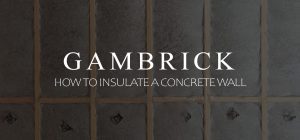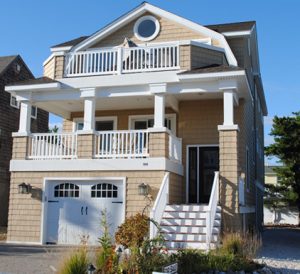

By John Mazzuca | About | More Posts |
John Mazzuca is a custom home builder with over 25 years experience in the construction industry. John has designed, managed, and built hundreds of homes & construction projects.
Should A Patio Be Flush With The Grass?
A ground level backyard patio is a great way to create space for entertaining, grilling or just plane relaxing on a warm summer day. The right patio height will vary based on the slope of the yard, the material your patio is made of and the design your trying to achieve. There are also codes that can dictate how low or how high the patio can be in relation to the ground. And then there’s water and drainage to consider. Your patio surface should be flush with the grass but it varies depending on how you cut your lawn. Ideally I build my patios 1/2″ to 1 1/2″ above grade. This provides enough distance between the ground and patio surface where grass can grow.
If you set your patio at exactly grade level, the grass will grow over the patio. This is a problem because grass adds height below your feet which makes the patio feel too low. It creates a tripping hazard and causes drainage issues. By placing the patio height slightly above grade, it creates the effect of being flush or level with the grass.
If you build the patio high it becomes like a small step. This triggers building code issues because a patio above grass is a tripping hazard. You’ll have to comply with the minimum allowed height for a step which is usually 4 inches.
In this article we’ll discuss more about patio heights, what they should be set at in relation to the grass and a few other common issues.
How High Your Patio Should Be
A ground level patio should feel flush with the grass when you step from the patio to the grass or vice versa. If you feel a height transition of more than a 1/2″ or so then you’ve probably built it too high or too low.
The grass adds some padding under your feet when you step on it which is around 1/2″ to 3/4″. This varies by the height of the grass, but it’s definitely higher than grade. This is why we build all of our patios slightly above grade. The grass will make up the difference between grade and the top of the patio.
Your patio should be 1/2″ to 1 1/2″ above grade.When you plant the grass this will make the patio top flush and level with the grass. It will create a perfectly smooth transition when you walk between the grass and patio.
This is easier than it sounds and assumes you have a level yard. Most yards have some sort of slope so take that into account when designing the patio. We do a lot of excavation work and sometimes build retaining walls to achieve and patio that’s level with the grass.
A 1% slope is when your yard goes down 1″ for every 100″ of travel. This is about the slop you want because it’s enough to drain water but not be noticeable when you step. And always remember to slope both the patio and grade away from the house.
Patio Height
Setting the height of your patio is harder when the ground is pitched.
1/2″ to 1 1/2″ above grade and flush with the grass is ideal. But in some cases that may not be possible on all sides of the patio because of the grade.
In cases when the grade is pitched you can level the ground with excavation or adapt the patio height to the yard. A patio doesn’t have to be level with the grass on all sides. I’ve built patios that were flush with the grass on one side, lower than grade on another which required a retaining wall, and higher on the opposite side which needed steps.
What you need to keep in mind is balance, usability, code compliance, visual appeal and structural integrity.
If I want to build a grade level patio without changing the grade, I try to always keep at least one side level with the grass. Then I adapt the patio to the grade. This requires some structural changes.
On sides where the grade comes up higher than the patio you’ll need a retaining wall to hold back the dirt. However on sides where grade falls below the patio, you’ll need to build steps or a foundation to support the patio. This usually requires footings.
Structural integrity is important to consider when the grade isn’t flat. Areas of the patio that aren’t flush with the grass will either have high ground or a drop to deal with. In the case of a drop, the foundation of the patio will be exposed to the elements and visible. Try to design something that’s not only attractive but also durable and weather resistant. I like using poured concrete.
Patio Slope
A patio shouldn’t be completely flat because it doesn’t promote good drainage. It should slope away from the house at around 1 to 2 degrees. This causes water to run off into the yard and away from the house. But it’s a mild pitch that you won’t feel walking or sitting on the patio.When a patio is flat water can pool up which can degrade the pavers, stones, grout or concrete.
Your yard is usually pitched in the same way. The highest part of the yard is right next to the house and sloped towards the edge of the property. This causes rainwater and water coming out of the gutters to run away from the house.
This is perfect because you can follow the natural grade of the yard with your patio. However, if the yard isn’t pitched properly or is sloped in uneven ways, you can excavate to level it off.
A slight slope difference between the yard and patio can be OK if you make it a part of your design. Keep the uneven areas safe and to code.
- At least one part of the patio should be even with the grass. This can be the main area where you walk from the patio to the grass.
- Areas that slope below the patio should have a strong weather proof foundation because it will be exposed.
- Areas that slope high should be excavated to meet the patio’s edge, landscaped or have a retaining wall.
If the yard slopes toward the house then you should excavated a swell to divert water away from the house and patio. You can also install an underground drainage basin and pipes to carry water away from the house.
Steep Slopes
If you’re yard has a really steep slope which causes the edge of the patio to either cut into a hill or have a steep drop, you’ll have to design the patio around the slope. I recommend keeping at least one edge of the patio level with the grass. Usually this will be along the sides of the patio near the house. Most yards slope as the get further from the house.
- If the patio cuts into a steep inclined hill, you’ll have to excavate and build a retaining wall to hold back the dirt.
- If the patio’s edge goes over a steep downward slope, you’ll have to build a foundation wall to hold up the patio. Make it strong because this will be visible and exposed to the elements. This is a good area to build steps if you want more access to the patio.
- If the drop is high I recommend adding a guard rail to prevent people from falling off the edge. This may also be required by code. Check with your township to find out how far the drop can be before needing a railing.
Another option is to build a retaining wall outside of the patio to level off the ground. This can hold earth in which builds up the height of the yard. Or it can hold earth back which requires excavating out dirt.
If you excavate and level a steeply sloped yard with retaining walls, the patio can be built level with the grass.
Basics Of A Patio Foundation
Patios need excavation, site work and possibly a full foundation in order to be built strong and durable. You can’t simply build a patio right on top of the dirt.
Understanding what happens before you start building the patio is very important because this is when you set the height of the patio top. If you want a ground level patio, it’s very important for some of it to be level with the grass.
To achieve a patio that’s flush with the grass, you have to establish the height by digging down the correct amount from grade.
The amount you need to excavate depends on the type of patio you’re building, how thick it is, and the material you’re using.
Patio Depth
The depth you need to dig down depends on the type of patio you’re building.
The more weight that’s going to be on the patio, the deeper you need to dig. A base material will be compacted beneath the patio to increase its strength. The more strength you need, the thicker the base.
For example, the average backyard paver patio requires 4″ to 5″ of compacted base material, but a paver driveway usually needs 8″ of base. This is due to the added weight the driveway will hold.
You then need to add 1″ of sand which is what the pavers sit on.
Finally you need to add in the height of your pavers, which on average are between 3 – 3 1/2″. To calculate the total depth of excavation required to get the patio level with the grass, you would create a formula like this:
4″ paver base + 1″ sand + 3″ paver – 1″ above grade = 7″ deep excavation. When calculating how much excavation you need to do, always remember to add the thickness of your base material, the sand and the paver together but then subtract between 1/2″ to 1 1/2″ of height. Factoring in patio height is important because this is what makes the patio level with the grass.
Other patio materials, such as concrete, brick or blue stone, work the exact same way, but they may require different base materials and/or sand.
Filler
Now that you’ve dug the hole, also called excavating, it’s time to compact and fill it with base material.
I recommend using a crushed stone called R-blend as a paver base. It’s durable, strong and compacts very tight which prevents the patio from settling. Spray some water on the base material as you compact it. This causes the finer materials to pull together and bond tightly.
Stone dust, sand, and compacted soil are also used as a base material but I don’t recommend them. They can settle or erode over time which then causes the patio to settle in spots.
Lay and compact crushed stone 2″ at a time. Once the first two inches are in and compacted down, wet the top slightly. Use just enough water to get the stones damp. Then lay another 2 inches and compact again. Then water again and so on. Repeat the steps until the entire base is in and compacted. Then wet and compact one final time.
Once all the base material is in, I wet it every day for a few days. Let it sit for a while and keep it damp. The water will help fine material to settle in place. If you notice a small spot shifting, fill it in with more stone and compact again. Don’t start laying sand or pavers until the base doesn’t move at all.
When you’re ready, lay 1″ of sand and compact it. This creates the floor your pavers will sit on so make sure it’s perfectly pitched and flat. I use PVC pipes and a screed to keep the sand uniform across the patio.
Not all patio materials need so much base. Concrete for example. can be poured over a thinner layer of compacted stone and doesn’t need sand.
Building The Patio
Once all the base material is in and compacted, it’s time to start building the patio. This could mean laying pavers, brick or stone or pouring concrete.
Pavers. Pavers and brick are pretty easy to install. Most of the time and effort goes into creating the base for them to pay on. But once that’s done all you do is place them down. Lay them on the sand gently. Even though sand is compacted, it’s still a fine material and easy to disturb. Lay the flat edge of the paver on the sand, not an edge. Press the paver up against the side of the neighboring paver without touching the sand. Then let it slide down into place.
Stone: Laying a stone patio is a little different because they’re not uniform like brick pavers. You have to be a bit artistic when you decide where each stone goes because there’s no preset pattern. But they go down just like pavers. Lay them gently on the sand one at a time as you work work your way across the patio.
Cuts: Making cuts is easy but you need a saw with a masonry blade. I use a regular skill saw and an angle grinder.
Gaps: Stone needs a gap that will either be filled with sand or grout later. But pavers butt up tightly to each other.
Concrete: Pouring concrete is totally different than building a stone, brick or paver patio. The concrete needs to be poured, tamped, smoothed and worked with floats and trowels. Stamps and color can be applied as the concrete dries. Relief cuts are made to relieve pressure and keep the concrete from cracking. Reinforcement like rebar are wire mesh are included inside the patio to increase its strength.
No matter which material you choose, keep the patio 1/2″ to 1 1/2″ above grade so the patio is flush with the grass.
Why We Build A Patio This Way
The reason all these foundation steps are taken is to create a strong and durable patio. Without a strong base, your patio won’t last very long. It could settle, crack, heave or break apart. But if the base is strong and stable, the patio won’t move.
Joints are another thing that benefits from a strong and stable base. Sand placed in between the pavers can slowly erode away due to weather and washing. But it won’t seep through the bottom of the paver because of movement. If the base is stable, the sand will stay in place and all you’ll have to worry about is the very top layer.
Weeds are another big factor. Patios built on a weak, thin base are prone to weed growth. But if you build a proper base, weeds can’t penetrate through so you don’t have to worry about them as much.
Finally there’s aesthetics to consider. A new patio is a big investment. And it’s one that can pay off for decades if you build it right. You want it to be stable, strong and look great. When we set the height of a patio to be level with the grass, that’s where it should stay. The edges shouldn’t settle or dip down over time. Weeds shouldn’t grow through, pavers shouldn’t become uneven and concrete shouldn’t crack. This is all due to a stable and strong foundation.
The Benefits Of Having A Patio Flush With The Grass
It’s better to have a patio that’s slightly higher than grade. I build all of our ground level patios 1/2″ to 1 1/2″ above grade. This puts the patio surface flush with the grass when it’s cut.
Here are a list of benefits to building a patio this way:
Drainage
A patio covers a lot of ground with a solid surface. This has a much different effect on your yards drainage than grass. Especially if the patio is made of large stones or solid concrete. This is why the patio’s pitch and slope are so important.
A major benefit of having a patio that’s raised above the grass is that water will run off and onto the lawn. If the patio was at grade level or below it, yard water would run onto the patio and cause issues. Standing water causes all sorts of problems for masonry.
Good drainage keeps the patio drier, cleaner and helps prevent water damage. If water sits on the patio or drains through the gaps, it can eventually undermine the foundation and cause dips or cracks.
Water always runs downhill even if the pitch is just 1%. Ideally, water should run off the patio and onto the lawn below.
The best height for a ground level patio is flush with the grass. This provides just enough distance for water to drain off and absorb into the lawn.
Weeds & Grass
A huge benefit of having a patio just slightly above grade level and flush with the grass is controlling weeds.
When a patio is first built it has a compacted base, possibly a sand layer, and usually a weed cloth. But weeds can still get under the patio and between the pavers from the sides. Since the patio is just slightly higher than grade, it’s harder for weeds to grow in.
Tripping Hazard
The grade should be lower than the patio by 1/2″ to 1 1/2″, but the patio surface should be level with the lawn. This looks the best and eliminates tripping hazards.
If there’s too much distance between the patio and the grass, it can cause a tripping hazard.
Looks
A patio is a big investment and a nice improvement for the home. You not only want it built strong, usable and safe, but also beautiful. Creating a smooth transition between the patio and lawn is ideal. This means building the patio 1/2″ to 1 1/2″ above grade.
Once the patio is built to the proper height, it’s up to you to maintain the lawn. Lawn mowers can be set to different heights. Tell your landscaper what measurement to cut the grass or set your own mower to the desired height. Keep this in mind when you set the height of your patio because some grass species can be cut shorter than others.
Should A Patio Be Higher Than the Grass?
A patio should always be higher than grade, which means the dirt not the grass.When you look at a set of plans and see the word grade, that means the ground, soil, dirt or Earth.
- If you’re building a ground level patio it should be flush with the grass which means building it 1/2″ to 1 1/5″ higher than grade. Then you would cut your grass to match the patio height.
- If you want a patio higher than the grass then it should be at least 1 step higher than grade. Usually that’s at least 4″ to 8″. If you build a patio less than a step high you’ll create a tripping hazard. If it’s too high, you won’t be able to step onto it without also building steps.
When a patio is higher than grade it makes it harder for weeds to grow and improves drainage. It also looks better and creates a smooth transition between the lawn and patio.
Summary: Should A Patio Be Flush With The Grass
A ground level backyard patio is a great way to create space for entertaining, grilling or just plane relaxing on a warm summer day. The right patio height will vary based on the slope of the yard, the material your patio is made of and the design your trying to achieve. There are also codes that can dictate how low or how high the patio can be in relation to the ground. And then there’s water and drainage to consider. Your patio surface should be flush with the grass but it varies depending on how you cut your lawn. Ideally I build my patios 1/2″ to 1 1/2″ above grade. This provides enough distance between the ground and patio surface where grass can grow.
If you set your patio at exactly grade level, the grass will grow over the patio. This is a problem because grass adds height below your feet which makes the patio feel too low. It creates a tripping hazard and causes drainage issues. By placing the patio height slightly above grade, it creates the effect of being flush or level with the grass.
If you build the patio high it becomes like a small step. This triggers building code issues because a patio above grass is a tripping hazard. You’ll have to comply with the minimum allowed height for a step which is usually 4 inches.
If you have any questions or comments about patios, email any time.

John Mazzuca | About | More Posts |
Custom Home Builder
John Mazzuca is a custom home designer and builder at Gambrick with over 25 years experience in the construction industry. John has designed, built and/or remodeled hundreds of homes, small buildings, and commercial projects. He writes about business, real estate, home building, and household electronics. His work has been featured in Fox Business, Better Homes & Garden, House Beautiful, and more.




















